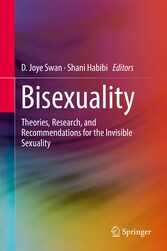Suchen und Finden
Service

Bisexuality - Theories, Research, and Recommendations for the Invisible Sexuality
D. Joye Swan, Shani Habibi
Verlag Springer-Verlag, 2018
ISBN 9783319715353 , 209 Seiten
Format PDF, OL
Kopierschutz Wasserzeichen
Geräte
Acknowledgments
6
Introduction
7
Contents
13
Contributors
15
1: Mapping Bisexual Studies: Past and Present, and Implications for the Future
17
Introduction
18
Ninteenth and Twentieth Centuries: Conceptions and Research about Bisexuality
18
Bisexuality and Research
21
Studies of Bisexual Identity Development/Management
21
Health/Disparities Research: Bisexual as Risk?
23
Bisexuality within Academia
26
Mapping the Future of Bisexuality Studies
28
References
31
2: Models and Measures of Sexual Orientation
35
Introduction
35
The Kinsey Homosexual–Heterosexual Rating Scale
36
Klein Sexual Orientation Grid (KSOG)
38
Storms Erotic Response and Orientation Scale
43
Sexual Identity Model
45
The Multidimensional Scale of Sexuality
46
Savin-Williams Assessment of Sexual Orientation
48
Sexual Configurations Theory
48
Conclusion
49
General Critiques of the Models and Measures
49
References
51
3: Defining Bisexuality: Challenges and Importance of and Toward a Unifying Definition
53
Why we need a definition of bisexuality
55
Who should define bisexuality? Society, the self, and science
56
Society as the definer. At the macro level, particularly in the USA, categorizing people based on their sexual orientation is widespread and triggers ingroup/outgroup social striations. For example, when heterosexual (Swan & Habibi, 2015) and e
56
The self as definer. The social belief that bisexuality is not a true orientation for either men or women exacerbates the problem of bisexual invisibility as well as the problem of defining a bisexual orientation. One way to negate social definit
57
Science as the definer. As I noted previously, the lack of a standardized definition of bisexuality has important consequences for researchers and their research. Without such a definition, not only are cross-study comparisons difficult, but w
59
What constructs should be included in a definition of bisexuality?
60
Summary, conclusions, and, at long last, a definition
69
References
72
4: Plurisexual Identity Labels and the Marking of Bisexual Desire
77
Conceptualizing Sexual Orientation
78
Sexual Identity and Sexual Marking
82
Marking Bisexuality across Time and Context
86
References
87
5: Bisexuality in Society
92
Introduction
92
Dominant Views of Sexuality
93
The Invisibility of Bisexuality: Absence, Appropriation, and Assimilation
96
Invisible Lives: Implications for Bisexual People
103
New Movements Towards bi-Visibility
104
Conclusion
104
References
105
6: Binegativity: Attitudes Toward and Stereotypes About Bisexual Individuals
109
Introduction
110
Content of Binegativity
110
Attitudes toward Bisexual Individuals—Gender and Sexual Orientation Differences
112
Factors Associated with Binegativity
116
Experimental Studies Examining Binegativity
117
Reducing Binegativity—Interventions and Promising Directions
120
General Conclusion
122
References
122
7: Female Bisexuality: Identity, Fluidity, and Cultural Expectations
126
Introduction
126
Self-Identity
128
Sexual Fluidity
130
Performative Bisexuality
132
Cultural Framings of Female Bisexuality
133
Conclusion: The Future of Female Bisexuality
135
References
136
8: The Male Bisexual Experience
140
The Number of Bisexual Men in the USA
141
Stigma toward Bisexual Men
141
Identity Development and Disclosure
147
Bisexual Men and Relationships
149
Bisexual Men’s Health
150
Bisexual Men and Resilience
150
Conclusion
151
Future Directions
152
References
152
9: Romantic and Sexual Relationship Experiences Among Bisexual Individuals
157
Introduction
158
Stigma Related to Dating Bisexual Individuals
158
Relationship Involvement, Mental Health, and Stigma Experiences
160
Maintaining a Bisexual Identity in the Context of a Relationship
162
Relationship Challenges Experienced by Behaviorally Bisexual Individuals Who Do Not Self-Identify as Bisexual
164
Intimate Partner Violence
166
Sexual Health
167
Conclusion
168
References
170
10: Well-Being: Bisexuality and Mental and Physical Health
176
Introduction
177
Mental and Physical Health
178
Mental Health
178
Physical Health
181
Considerations for Mental Health Practitioners
184
Assessment
184
Coming out
189
Education and Training
191
Case Management
192
Advocacy
192
Conclusion
193
References
194
Concluding Remarks: A Perspective on Envisioning Bisexuality as Inclusive, Celebratory, and Liberatory
200
Introduction
200
Inclusive Bisexuality
201
Celebratory Bisexuality
203
Liberatory Bisexuality
203
References
204
Correction to: Bisexuality: Theories, Research, and Recommendations for the Invisible Sexuality
205
Correction to: D. J. Swan and S. Habibi (eds), Bisexuality, https://doi.org/10.1007/978-3-319-71535-3
205
Index
206
Shop


